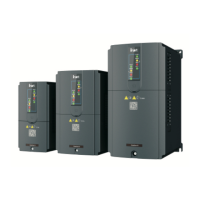Goodrive18 series two-in-one VFD Product overview
-4-
2 Product overview
2.1 Quick startup
2.1.1 Unpacking inspection
Check the following after receiving the product.
Whether the packing box is damaged or dampened.
Whether the model identifier on the exterior surface of the packing box is consistent with
the purchased model.
Whether the interior surface of the packing box is abnormal, for example, in wet condition,
or whether the enclosure of the VFD is damaged or cracked.
Whether the VFD nameplate is consistent with the model identifier on the exterior surface
of the packing box.
Whether the accessories (including the manual and keypad) inside the packing box are
complete.
If any problems are found, contact the local dealer or INVT office.
2.1.2 Checking before applying
Check the following before applying the VFD.
Note: Do not carry out insulation voltage-endurance test on the VFD, or measure the control
circuits of the VFD with megameter.
1. Check the load type to verify that there is no overload of the VFD during work and check
whether the power class of the VFD needs to be modified.
2. Check whether the actual running current of the motor is less than the rated current of
the VFD.
3. Check whether the control accuracy required by the load is the same of the VFD.
4. Check whether the grid voltage is consistent with the rated voltage of the VFD.
2.1.3 Environment
Check the following before the actual installation and use:
1. Check whether the ambient temperature of the VFD exceeds 40°C. If it exceeds 40°C,
derate 1% for every increase of 1°C. It is not recommended to use the VFD if the ambient
temperature exceeds 50°C.
Note: For a cabinet VFD, the ambient temperature is the air temperature inside the cabinet.
2. Check whether the ambient temperature of the VFD in actual use is lower than -10°C. If
yes, use heating facilities.
Note: For a cabinet VFD, the ambient temperature is the air temperature inside the cabinet.

